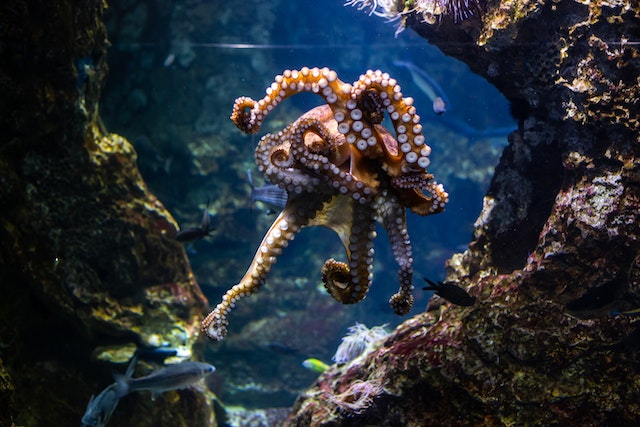
How does an octopus’s suction cup work? It reduces the pressure inside the sucker to create an extremely strong seal.
Incidentally, I’m going with octopuses as the plural of octopus. Octopi is equally valid, but octopuses is apparently the more common term amongst the scientific community. Octopus comes from a Latin word and when Latin words end in -us, they are pluralized to -i. This has stuck in English with words like alumnus, alumni. However, as octopus is no longer a Latin word, octopuses seems to be perfectly acceptable.
Octopuses have 8 arms with muscles but no bones. Sometimes they are called tentacles, but they are arms. The difference is that tentacles only have suction cups on their ends while arms have suction cups all along them. They have no bones but their arms have an incredible range of motion and strength. We could not move our arms if our bones were removed, but octopuses control their arms in the same way we control our tongues or an elephant controls its trunk. They are called muscular hydrostats and they have muscles that go lengthwise and crosswise. They can pull the muscles against each other to get the range of movement.
Each arm has a huge number of suction cups. It obviously depends on the size of the octopus, but the largest octopus, the giant pacific octopus, has 2,240 suction cups. Each one of these cups can be controlled individually. Octopuses don’t just use the suction cups to grab and hold things, they are also able to touch and taste with them because each suction cup has touch and taste receptors. If an octopus is trying to find what is in a dark cave, for example, it can stick its arm in and search the cave through touch and taste. There is so much information being sent all the time that the octopus has a mini brain, called a ganglia, at the top of each arm. Ganglia are clusters of nerves and they are able to control the arms and the suction cups, and deal with the information from the suction cups independently. That’s why an octopus’s arm can continue to move for a while if it is cut off.
So, how does an octopus use its suction cups? Each suction cup has two parts, called the infundibulum (lower chamber) and the acetabulum (upper chamber). The infundibulum is the outside bit, the part that you can see. It has grooves and ridges to help it grip and form a perfect seal. The acetabulum is the inside chamber that provides the suction. The suction cup has three sets of muscles: one set in the infundibulum, and two sets in the acetabulum. When the octopus wants to grab something, the infundibulum touches the object and the muscles shape it so that it is completely flat against the object’s surface. Then the two muscles in the acetabulum contract, pulling up the top of the infundibulum. This increases the volume of the inside of the chamber, but water cannot get in because the muscles keep the seal tight. Because the volume increases and the amount of water doesn’t change, the pressure inside the suction cup drops. The pressure of the water outside the suction cup is far greater than inside, which makes the suction strength very strong. A great pacific octopus can hold a weight of about 16 kg from its arms using its suction cups. When the octopus wants to release the suction cups, it just relaxes the muscles and the pressure equalizes. An octopus suction cup is far stronger than the type of suction cups we use in our bathroom because water is heavier than air and the pressure pushing down on the suction cup is far greater under the sea.
Scientists are not completely sure how, but octopuses are able to maintain their grip for several hours. If it was only muscles at work, they wouldn’t be able to do this because muscles tire. Imagine trying to hold a rope that is being pulled in your hand for several hours. Scientists think that the muscles are somehow able to store elastic energy so that they can stay tight without tiring, in a similar way to tendons. Octopuses also have microscopic hairs in their suction cups which scientists believe help increase the suction strength as well. Some shellfish that stick to rocks have these hairs as well. The combination of the hairs and mucus might help the octopus keep its grip without using energy, but nobody really knows why.
If you are grabbed by an octopus, it is possible to remove their suction cups with your hands, but you have to go suction cup by suction cup and break their seal so that they fill with water. And this is what I learned today.
Photo by Ann Antonova: https://www.pexels.com/photo/octopus-in-the-water-near-the-coral-reefs-5986729/
Sources
https://www.dictionary.com/e/octopuses-or-octopi/
https://www.wired.com/story/how-octopuses-use-their-suction-cups-to-taste-through-touch/
https://www.scuba.com/blog/sticky-business-octopus-tentacles-work/
https://www.sciencefocus.com/nature/how-do-octopuses-move-their-limbs-if-they-have-no-bones
https://www.discovery.com/science/Octopus-arms
https://blogs.scientificamerican.com/octopus-chronicles/tiny-hairs-helps-octopus-suckers-stick/
https://academic.oup.com/icb/article/42/6/1146/698313
